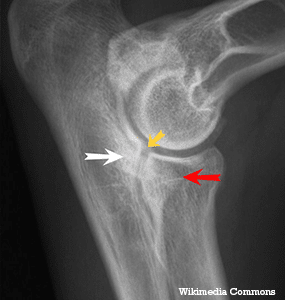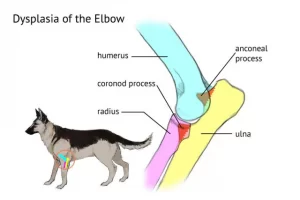ELBOW DYSPLASIA
Dysplasia is a term that reflects abnormal development, and collectively Elbow Dysplasia leads to disturb the elbow joint development. It is a common skeleton condition that causes the front leg to limp in dogs. It is treatable and needs early diagnosis and prompts cure by an expert.
How does Elbow Dysplasia develop in dogs?
Elbow Dysplasia in young dogs is the main reason of lameness due to their conformational abnormalities. The abnormal growth of the three bones that make the elbow joint leads to forming the condition of Elbow Dysplasia. These bones include the radius, ulna, and humerus.
The unequal distribution of forces on the elbow joint results in degeneration of the joint. The condition worsens in later stages and imparts severe pain, arthritis, and ultimately lameness in dogs. There are chances of cartilage degeneration which also exaggerates its severity.
Most of the studies reveal that it is a congenital disease which means it has a genetic origin. On the other hand, there are different theories that support its origin from trauma, diet, and cartilage growth abnormalities.
Broadly speaking, any condition that results in growth disturbances of the elbow joint could be the cause of Elbow Dysplasia.
How to tell my dog has Elbow dysplasia?
Elbow dysplasia imparts severe pain to dogs when they try to get up from the sitting position. The signs and symptoms of elbow dysplasia are easily observable, just like other degenerative diseases of the skeleton. There is a reduction in the joint range of motion in the early stages, which need to catch up as soon as possible.
The extension and flexion of the elbow joint also affect to a great extent and inflict pain on the dog. Moreover, the abduction of forelimbs is also evident during the phase of elbow dysplasia. In addition, the dog experiences great discomfort with intermittent lameness.
You can easily observe the abnormal gait pattern of your affected dog. The condition initiates with the slight change in weight shifting behavior and progresses to develop persistent lameness. Sometimes, there is a formation of fluid within the elbow joint that can be easily palpable.
What are the clinical signs of Elbow Dysplasia in dogs?
The clinical signs of Elbow Dysplasia depend upon the severity of joint deformation. General indications include;
- Infliction of pain upon joint extension and flexion
- Problematic getting up
- Signs of joint inflammation
- Hesitation to walk and jump
- Reduction in joint range of motion
- Abduction of elbows
- General swelling in elbow joints (one or both)
- Abnormal gait pattern
- Lameness
 What are the causes of Elbow dysplasia in dogs?
What are the causes of Elbow dysplasia in dogs?
Elbow Dysplasia may result from several skeletal conditions that cause problems to elbow joints. The presence of one or two of these conditions increases the risk of developing Elbow Dysplasia in dogs. These are as follow;
1-Fragmented Coronoid Process
In this situation, the wearing of joint cartilage results due to the irritation of the cartilage lining by the fragment of bone.
2-Ununites Anconeal Process
It results from the improper closure of the growth plates that imparts the joint degeneration due to the detached piece of bone.
3-Elbow Incongruency
The main reason behind is condition is the imperfect joint structure that ultimately leads to the wearing of elbow joint cartilage.
4-Osteochondrosis Dissecans
There is degeneration in the elbow joint cartilage, whose consequence is seen in the form of joint pain and inflammation.
All these conditions are the leading cause to hinder the joint range of motion and make dogs helpless.
What should be the diagnostic approach in the case of canine Elbow Dysplasia?
In young dogs, whenever you observe any abnormal walking or gait pattern, you should seek the way of veterinarian. The in-depth orthopedic examination of your dog can better tell the actual condition of the disease. For this purpose, veterinarians perform radiography (X-rays) to note the skeletal deformations.
Radiographs, sometimes, require an expert in this field to observe the subtle changes in growth plates. There might be minute conformational changes in elbow bones that veterinary radiologists only observe. Moreover, in certain cases, radiology is not sufficient to provide the necessary details.
In such conditions, modern imaging techniques perform their roles. MRI and CT scans can better help confirmatory diagnosis of Elbow Dysplasia at early stages.
How veterinarians treat Elbow Dysplasia in dogs?
In mild conditions, the provision of conservative medical options is the best option to slow down its progress. On the other hand, a fiberoptic scope which is also known as arthroscopy is carried out to root out the loose flaps in the elbow joint.
In the managemental approach, the use of anti-inflammatory drugs to relieve pain, combined with Hydrotherapy and physiotherapy to maintain strength and Mobility. Joint supplementation can also be used.
Conclusion
Elbow Dysplasia is the deformation of the elbow joint that results in severe pain and irritation for dogs. In the early stages, the treatment options are available and are easy to conduct. On the other hand, in severe cases, surgical intervention is the only option for veterinarians.



 What are the causes of Elbow dysplasia in dogs?
What are the causes of Elbow dysplasia in dogs?